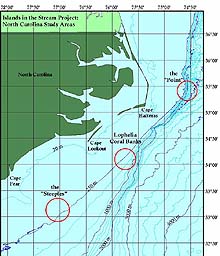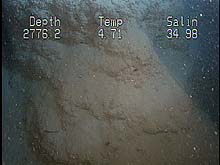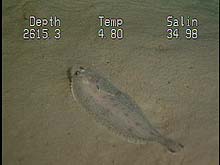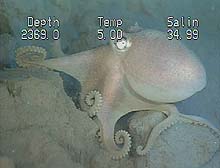
This map shows the areas to be studied during the North Carolina Shelf leg of the Islands in the Stream Expedition. Click image for larger view.

Sloping, muddy sediments cut by narrow canyons characterize the terrain of "The Point." Notice the white specks, called "marine snow," falling in the foreground. This "snow" is composed of fine-grained sediments and organic matter. Click image for larger view.
'The Point': A Unique Marine Environment
September 21, 2001
Steve Ross
Research Coordinator
North Carolina National Estuarine Research Reserves
Ken Sulak
Research Fish Biologist
U.S. Geological Survey
Along the U.S. East Coast from the Norfolk Canyon (Virginia) to just south of Cape Hatteras, NC, the continental slope is characterized by thick, steeply sloping, muddy sediments that are deeply incised by narrow canyons separated by knife-like ridges. At the base of the slope, where the sea floor begins to level out, massive deposits of sediment, which have slumped from the surrounding scarps, can be found. The central portion of this region, just north of Cape Hatteras, is known as "The Point." It is an area along this slope where different water currents converge, and a diversity of species meet, to create a unique and highly productive habitat.
Where Currents Converge
Three major ocean currents converge at the Point. Here, the northerly flowing Gulf Stream meets the southerly flowing Virginia Current, and turns to the northeast. The Gulf Stream also crosses the underlying, southerly flowing Western Boundary Undercurrent at the Point, creating a zone of no net motion, where fine-grained sediments and organic matter rain down as "marine snow" and settle on the steep slopes. Given these conditions, the Point is a rich and diverse system supporting everything from microscopic organisms that form the foundation of the food web, to large pelagic fish species and pods of dolphins and whales.

The witch flounder (Glyptocephalus cynoglossus) feeds on small shrimp, marine worms, and mollusks. Its grayish-white body allows it to blend into the muddy bottom. Click image for larger view.

The witch flounder (Glyptocephalus cynoglossus) feeds on small shrimp, marine worms, and mollusks. Its grayish-white body allows it to blend into the muddy bottom. Click image for larger view.
The Point's Species and Habitat
The combination of steeply sloping canyons and ridges and converging currents at the Point has helped create a unique and mysterious
Ienvironment teeming with life. Unusual communities of fish and invertebrates can be found at the surface, down through the water column, and living on or in the underlying sediments. One puzzling characteristic of the dominant bottom-fish species is their diminutive size; so much so, that scientists refer to this mix of small species as the "Lilliputian" bottom-fish fauna!
The extremely rugged canyons and ridges of the Point -- soft muds carved into cliffs, overhangs, and Bryce Canyon-like features -- are home to a wide variety of species. Amazingly, bottom fish rest on this substrate in apparent disregard for the slope of the bottom. It is not uncommon to see witch flounder, squid, and eelpouts perched on a 90-degree slope (heads up or down). In some places, especially where the canyon sides are steep, animals such as crabs and fish have excavated small caves, some of which are shared by several different species. Also, the animals themselves may use each other for habitat. Colonial worms and giant foramaniferans (white-shelled, bottom-dwelling invertebrates), for example, may create structures on the bottom that serve as shelter for other fish and invertebrates. It is common to see blackbelly rose fish curled alongside a large anemone.
Despite the special problems of deep-sea existence and the unique conditions represented by the Point, this area has the very positive feature of having abundant food sources (small shrimp and amphipods) through most of the water column. Additionally, there is no other place on the U.S. coast where such diverse water currents, rugged geology, and high animal densities combine in a relatively small area.
Sign up for the Ocean Explorer E-mail Update List.











































